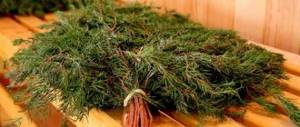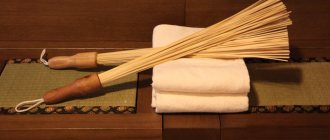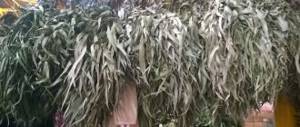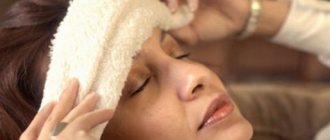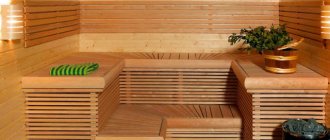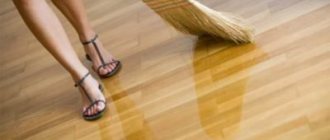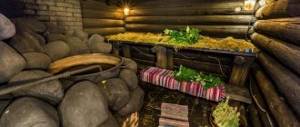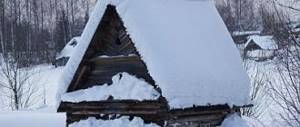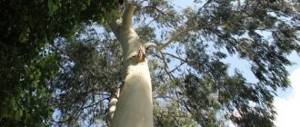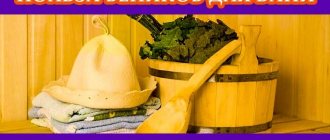A nettle broom for a bath is an excellent way to combat not only rheumatism and radiculitis, but also an effective remedy against skin diseases. To get the maximum result, you need to accurately understand what materials can be used for the preparation, and how to properly make this bath “tool”.
Indications and contraindications
Indications for use:
- anemia, tuberculosis;
- bronchitis, arthritis;
- gout, rheumatism;
- eczema, colds;
- boils, acne;
- alopecia.
Bath procedures allow you to quickly cope with the symptoms of colds.
Contraindications:
- hypertension;
- kidney disease;
- first trimester of pregnancy;
- increased body temperature, blood pressure;
- the presence of ulcers, open wounds;
- mental disorders;
- diseases of the cardiovascular system;
- malignant neoplasms.
Because nettle increases blood clotting, it should not be used by people with high cholesterol levels as there is a risk of blood clots.
What are the benefits of a nettle broom?
Nettle is widely used in cosmetology, folk medicine and cooking. In addition to dishes, decoctions, shampoos, medicinal ointments and tonics are made from it.
Formic acid, present in the plant, acts as an antiseptic, simultaneously providing a tonic and regenerating effect. Tannins and mineral salts have a positive effect on blood flow, normalizing blood pressure.
Nettle improves skin elasticity and stimulates collagen production
A nettle broom in a bath and steam room is used for the following health problems:
- rheumatism and radiculitis;
- gouty conditions;
- tuberculosis;
- arthritis;
- acne (boils, acne);
- eczema;
- severe hair loss, alopecia.
This remedy is especially recommended in the presence of chronic colds (tonsillitis, pharyngitis), acute respiratory infections and acute respiratory viral infections. Using a nettle broom helps relieve fatigue, helps normalize the functioning of the nervous system, and relieves insomnia and stress.
Important! To achieve a pronounced effect, you need to steam with a nettle broom regularly.
Methods of application
Features of application:
- You can't whip the body too hard.
- The massage begins from the neck, slowly moving down to the legs. Initially, there will be a tingling sensation, which will gradually be replaced by a pleasant warmth.
- Before you start performing bath procedures, you should sit in the steam room for 5 minutes.
- Before using the branches, you must rinse them with hot water.
If the plant will be used for cosmetic purposes, it is better to choose young shoots, since they contain more useful substances.
How to use a nettle broom
How to use a nettle broom
Unlike traditional brooms, nettles should not be whipped too hard on the body. Touches should be light and careful, and the massage should begin from the neck, gradually moving to the legs. If everything is done correctly, a slight tingling sensation will appear and a pleasant warmth will spread throughout the body. After the procedure, the skin becomes bright red, and in overweight people it even acquires a crimson tint. There is no need to be afraid of this, the normal color will quickly be restored.
How to steam with a broom correctly
To get rid of pain, you first need to warm up in the steam room for 5-7 minutes, then it is advisable to lightly pat the skin with an oak or birch broom so that the pores open well. Then you should dip a nettle broom in boiling water for a couple of seconds and whip the sore spots. Acne on the face is treated by applying steamed leaves to the skin for several minutes in 2-3 passes.
A nettle broom is applied to the face
For cosmetic purposes, fresh young nettle is best. Cut about 10 densely leafy stems up to 60 cm long, tie the lower end with twine, dip in hot water and begin to steam. Touching the body with a broom should be very light, stroking. You can lightly fasten on your stomach and thighs to stimulate blood circulation. If you don’t have fresh nettles, use dry ones, steaming them in hot and cold water.
Nettle decoction
To make your hair beautiful, you can use nettle infusion by rinsing your hair with it after a steam room. In order not to specifically prepare a decoction, many simply take two brooms to the bathhouse, and pour boiling water over one of them in a separate container. While a person is steaming, nettle saturates the water with useful substances. At the end of the steaming, all that remains is to pull the broom out of the container, dilute the water to a comfortable temperature and rinse the whole body.
Water after steaming a broom is good for children's skin and hair
Manufacturing
Making a broom with your own hands is easy. To do this, you need to know at what time, where to collect consumables, how to properly steam and dry a bunch of shoots.
Time and place for collection
Principles for choosing a place and time for collection:
- The plant is best harvested in May-June. During this period, the stems are more juicy.
- You cannot choose plants located near roads or large enterprises.
- Cutting is carried out in dry weather. You can't do this after it rains.
Selection and rules for collecting plants
When collecting nettles you need:
- Choose young shoots.
- Use protective gloves.
- Cut the stems with sharp scissors or a knife. Retreat about 10 cm from the ground.
Avoid cutting stems in hot weather. In extreme heat, the leaves wither and fall off faster.
Steaming
After preparation, the shoots need to be steamed:
- Place the bunch in boiling water and hold for 2-3 minutes.
- Dip it in cold water after hot water for 2-4 minutes.
- Repeat the procedure 3 times.
Before use, the broom should be doused with boiling water.
Drying
Drying Features:
- Start drying 3 days after cutting the stems.
- Clear the lower parts of 15 cm of leaves.
- Lay the branches on dry newspaper or the floor so that they are not exposed to the sun's light.
- After two days, hang the stems on a stretched thread, open the doors and windows to ventilate the room.
Creation
To create a broom, you need to prepare thick twine and prepared nettle shoots. Thick stems should be placed on the outside, thin stems on the inside. Tie the bundle with twine at the end of the handle.
Steaming methods
Broom steaming scheme
The process of steaming a nettle broom is slightly different from the traditional method. To prevent nettle from losing its beneficial properties, it should not be kept in boiling water, like oak or birch branches. For steaming, prepare two containers - with cold and hot water (approximately 75-80 ° C). First, dip the broom in hot water for 2 minutes, then dip it in cold water for the same time. Repeat the procedure 2-3 times, after which the broom is ready for use. This method is chosen by those who need a soft and gentle vaping regime.
If you need to get rid of pain, use the second method of steaming nettles. To do this, the broom is dipped in hot water for 2 minutes or in boiling water for 2-3 seconds, after which it is used for its intended purpose. Before such a procedure, it is necessary to properly warm and steam the skin. Now all that remains is to figure out how to properly use a nettle broom to achieve maximum effect.
Steaming a broom
Who should be careful with steam rooms?
The benefits of nettle in the bath are undeniable, but like all traditional medicine, it has contraindications. The active substances of the plant increase blood clotting, so doctors do not recommend using these accessories for people with the following diseases:
- Hypertension.
- Thrombophlebitis.
- Phlebeurysm.
- Atherosclerosis.
- Increased body temperature.
In addition, nettle bath brooms should be avoided during pregnancy and the lactation period. Open wounds or skin tumors also become a reason for the ban.
How to prepare a broom
Unfortunately, you won’t be able to make a strong, durable nettle broom. But, I know bath attendants who prepare such brooms for the winter. For collection, choose good-quality branches, without flowers or seeds. They are dried in the shade, in the free air. Then large herbal bouquets are collected and tied. They are stored in a barn, on a veranda, in the shade, suspended from the top by the handles.
As I have already repeated many times, any herbal brooms are not famous for their durability and nettle brooms will not be an exception. Due to long-term storage, the leaves break and crumble; be prepared for the fact that there will be a lot of cleaning in the bathhouse after using a dry broom.
In conclusion of my story, I want to add that I myself was very afraid of the nettle broom. But the torment with my back and knee joints, when they simply “turned”, forced me to overcome my fear. Nettle does not sting in the bath, there are no burns or unpleasant sensations after it. But all my ailments went away, Mother Nettle cured them.
If you steam with a nettle broom wisely, correctly and without ostentation, then there will be only one benefit from the procedures. And after trying it once, the insidious fear of stinging hairs will run away from you without looking back, and you won’t be able to imagine your next bath ceremony without nettles.
BE HEALTHY DEAR READER!
The Russian steam room, as well as the accessories used in it, is one of the best folk remedies for getting rid of many ailments. A nettle broom for a bath has been considered the best tool for healing since ancient times. With its help, ancestors got rid of skin diseases, radiculitis, gout, rheumatism and arthritis.
Stinging nettle has a tonic effect and is an excellent prevention of colds. It should be remembered that the therapeutic effect can only be achieved by having knowledge of the correct preparation of the plant, steaming and use, because improper use will give nothing but burning pain and possible harm to health.
In this material we will tell you not only about the medicinal effects of the healing herb, but also about how to make a nettle broom with your own hands.
How to make a nettle washcloth with your own hands
A good alternative to a nettle broom for a bath can be a washcloth made from this plant. The raw materials for it are collected after the end of the long rains in September. After such intense saturation with moisture, the nettle skin is easily separated, then it is dried and rolled into a convenient sponge-twig.
Use only juicy, well-moistened grass for sponging
Let's take a steam bath - maybe nettle?
- A plant that replaces 7 healers and one mage
- Collection, drying and storage of brooms
- How to use?
- Herbal bags or again about the benefits of plants
- Quality of firewood of different tree species
- Roof for a log house 5 by 6 - try it ourselves
- A noble oak broom for body and soul
Amazing things happen: the more perfect science and medicine are, the less skepticism remains towards traditional methods of treatment. This explains the miraculous transformation of “Cinderella” - nettle - into the “prom queen”. It’s not surprising, the “bicycle” is being invented with enviable consistency. If your bones ache or your joints hurt, you need to use nettle bath brooms, which have been used for centuries in Rus'.
We suggest you find out at what distance from the fence you can build a bathhouse
Medicinal plants help with certain diseases, only a few are considered universal “green healers”. The most famous herb for everything and for everything is nettle. Its hemostatic, analgesic, tonic and cleansing properties are most valued.
Since ancient times, people have noticed that nettles are found where people live. The green, burning bushes resemble a gloomy-looking man with a “golden” heart. In the old days they said that God provided nettles with fire to protect them from destruction. Animals and humans would have destroyed the succulent plant long ago if it did not have stinging hairs.
In Rus', every owner and mistress of a house with an established life knew what they were supposed to keep from the “green” pharmacy. In the summer we stocked up on herbs,
brooms for the bath. Nettle took pride of place among the bundles of fragrant mint and green wormwood, dried in the attic or in a Russian oven. The bathhouse and the stove were considered the best healers, and nettle was called “the herb that replaces 7 healers.”
To stay healthy, peasants added herbal decoctions to a vat of water installed in the steam room. They took fresh nettles with them to the bathhouse or dried ones, mixed with tree branches. The herb was considered witchcraft and was placed under the bed of a sick person to heal him and protect him from dark forces. Russian doctors in the 17th century treated wounds and ulcers with the fresh plant, and recommended lubricating the head with the juice to prevent hair loss.
A bitter but noble family
Touching it causes fragile hairs to break off, which immediately injure the skin. The picture of the plant’s struggle with the “attacking” animal or person is completed by the release of caustic formic acid. The family Urticaceae ("stinging") includes the genus Nettle (Urtica) - perennial or annual herbs with serrated leaves.
1. Stinging nettle. The height of the perennial plant is 50–170 cm. The straight tetrahedral stem and petiolate, ovate-heart-shaped leaves are dotted with stinging hairs. A common species in temperate latitudes.
2. Stinging nettle. A modest herbaceous annual 20–70 cm high. Small oval leaves are covered with stinging bristles. A common species in the Northern Hemisphere.
3. Hemp nettle. An elegant herbaceous perennial with large, deeply palmate leaves. Found in Russia, China, and Central Asia.
4. Ball nettle is found in the Caucasus and Crimea. Straight stems reach a height of 20–70 cm. The leaves are large, the apex is pointed. The inflorescences form flirtatious balls.
Dioecious is found in gardens, wastelands, floodplain forests and on the banks of reservoirs. “Sybarites” from the plant world prefer soils rich in moisture and nutrients.
Pantry of vitamins and minerals
The useful plant has a hemostatic, antibacterial and stimulating effect. Juice and decoction from it prevents hair loss on the head. Brooms made from fresh grass and prepared for future use contain an exquisite set of vitamins, acids, salts and sugars. Stinging hairs are a generous “pharmacy” offering formic acid - a natural antiseptic, bioregulators - histamine and acetylcholine. The complex created by nature reduces pain and treats polyarthritis, radiculitis, rheumatism (articular and muscular).
1. Vitamins: C, A, E, K, B2, B9, PP. 2. Organic acids: formic, pantothenic. 3. Proteins and proteins. 4. Tannins. 5. Urticin glycoside. 6. Quercetin. 7. Phytoncides. 8. Chlorophyll. 9. Calcium and potassium salts. Silicon dioxide, sulfur, phosphorus. Microelements: iron, copper, zinc, manganese. 10. Comedy.
The active ingredients of nettle are preserved in a properly prepared bath broom. This is a popular remedy for people suffering from gout and musculoskeletal diseases. Such a broom is useful for bruises; the “green healer” cleanses and heals wounds.
Harvesting nettles begins in May, but it is better to do this during the flowering period from July to September, when the leaves are already mature. Typically, plants are mowed in vegetable gardens, vacant lots, and forests far from highways. Nettles must be dry, otherwise the leaves will quickly turn black and the stems will become covered with fungus. Collect on a sunny day, the first half of it. The branches (45 cm) are first cleared of the lower leaves and tied so that the shape of the broom remains flat.
Problems with making and drying nettles - its branches darken if they do not dry quickly enough. The grass should be placed under a canopy, in the attic, hanging by the stems. You can place the brooms in a draft and turn them over regularly. After drying, the branches are inspected and the blackened ones are removed.
In combined brooms, nettles are placed on top. The prepared bath attributes are tied in pairs and hung in a well-ventilated room protected from the sun. So the “green pharmacy” and “pantry” of vitamins are ready.
How to use?
In the bathhouse, fresh stinging nettle or stinging nettle, tied in small brooms, is dipped into hot water before use, and then into cold water (for a few minutes). The procedure is not burdensome, because it helps to avoid burns. It happens that for therapeutic purposes, it is the burning properties of the healer that are important.
If kidney function is impaired or you are tormented by neuralgia, then a steamed broom should be applied to the sore spot. Scalded nettle leaves emit healing steam that cleanses pores and fights blackheads, acne and boils. Before this procedure, pour boiling water over a broom and gently stroke the skin with it.
• relieves aches from colds; • reduces pain in osteochondrosis and radiculitis; • increases skin elasticity, reduces irritation; • eliminates excessive sweating.
The combination of plants in a broom enhances the healing effect on the source of pain. Combined brooms are popular - nettle with birch or oak. The correct choice of plant pairs and distribution of stems is a real art. With birch branches, the necessary flexibility is achieved, but there is no need to whip the body too much. It is enough to treat the sore spot with a broom for 3–4 minutes.
• heat; • feverish condition; • exacerbation of a chronic disease; • hypertension; • varicose veins, thrombophlebitis.
Nettle broom is an indispensable companion to this
Russian bath. The beneficial herb is revered by folk medicine for its healing effect and pain relief. The famous European painter Albrecht Durer depicted on his canvas an Angel flying with a nettle in his hand. A wise and talented artist considered this burning plant pleasing to God.
I recommend reading: Choosing a wood-burning stove up to 10 thousand rubles
How to properly harvest nettles for brooms
You need to cut nettles for brooms until they bloom. Plants choose those that grow in the shade.
Nettle has several varieties: stinging nettle, stinging nettle and stinging nettle. All these types have varying degrees of pungency. While dead nettle hardly stings, stinging nettle burns more than stinging nettle.
The nettle harvest season lasts from May to July.
How to steam a broom
Most bath brooms are steamed. To make the broom soft, flexible and biting, you need to carry out a certain ritual of soaking and steaming with water. A fresh herbal broom does not need this at all.
Too hot water will simply boil the nettle broom, that is, the traditional method of brewing the broom will not work. But it still requires some preparation...
The most valuable thing about this herbal broom is its stinging properties. This is a benefit and a burn at the same time. In order for the nettle to burn and sting “more carefully”, more carefully, without causing much harm, its branches must be moistened with water.
Boiling water cannot be used for these purposes. It is enough to dip the broom in warm water for a few seconds, then shake it and let it breathe in the heat of the bath. This technique can be repeated several times.
I know brave souls who don’t soak nettles in water at all, but prefer to steam themselves with a real stinging fan. But only experienced steamers can achieve such records; I do not recommend this method of steaming to beginners.
How to make a broom
Nettle is one of the few herbs that makes a pretty decent broom. Of course, it will not be enough to use for a long time, but there is no shortage of raw materials.
In the hot bathhouse kingdom, she loses her burning weapon, only she needs to be carried to the bathhouse and a broom built. Therefore, put on good-quality work gloves and go collect your future broom.
Of course, you need to choose only clean places where nettles grow. Do not collect grass from garbage dumps, near construction sites, or along roads - there will be no benefit from it, only harm. The grass literally absorbs dirt and muck into itself, therefore, it will give back the bad.
Stinging nettle is a must for bathing procedures; try to choose a plant that has no color at the edge. Otherwise, you will cover yourself and the entire bathhouse with seeds. The stem of the plant should be strong, not frail. Any herb is not known for its bite, and under the influence of the heat of the bath and steam it quickly turns into a mushy bouquet. Therefore, a broom needs strong branches.
Don’t skimp on nettle branches for your broom; the more you collect, the more magnificent it will be, and the longer its service life in the steam room will be. In order to build a convenient broom, it is better to cut the branches about 25-30 cm long. To get a comfortable handle for the broom, the leaves at the base must be removed. The length of the handle can be different, the main thing is that it should fit freely in your palm.
You don’t really need to tie the herbal brooms, a simple bandage with twine is enough (personally, I like to tie the nettles with a simple bandage, the handle is comfortable, soft and doesn’t sting).
If you still have mistrust and fear of nettle broom, you can advise trying to add a few branches of birch, willow, and currants to its composition. They will enhance its bite, add additional aroma, add their benefits and increase the service life of the broom.
